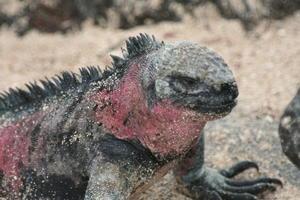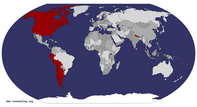Advertisement
Published: April 4th 2006

 Marine Iguana (Espanola)
Marine Iguana (Espanola)
This male is showing off the beautiful pink and green colors that are unique to the marine iguanas of this island.Espanola Island 3-29-06
Matt and I are going to switch back and forth for these entries, so Sara will be your interpreter for this section of the Galapagos. Our overnight boat ride to Espanola was a bit bumpy but the Bonine was in full effect and we slept well with no nausea. We woke up to our usual fantastic 7 am breakfast (fruit, toast, eggs, cheese, tea/coffee, juice, and meat for the carnivores) and then we headed to Punta Suarez for our early day hike. The landing was dry but the docking point was covered with sea lions and brightly colored pink and green marine igaunas. The sea lions were so prolific that a mama thought I was a bit close to her baby and she chased me back onto the dock. There are 4 species of mockingbirds in the Galapagos and Espanola has its own species (the largest), the Hood mockingbird. They are completely unafraid of humans and boldly sit on your shoes or even your hat (according to the guidebook) begging for a sip from your water bottle. While we did not oblige their request for water, they were so close that we got many great pictures of

 Lava Lizard (Espanola)
Lava Lizard (Espanola)
The iguanas are not the only ones with very bright colors on this islands as this lava lizard can attest to.them and their amber eyes!
As we began our hike, a Galapagos hawk flew and perched on the stone national park monument that is present on most islands. We took advantage of this photo opportunity since the hawks are also endemic to the Galapagos and are striking large brown hawks with yellow bills. We only walked a little ways on the trail when we heard the blue-footed boobies either whistling (males) or honking (females) to attract a mate. Their mating ritual is fantastic as both sexes prance, dance, and shakes their wings before our very eyes. The birds are completely unaware or unbothered by humans and many blue footed boobies danced only a foot or two away from us. While the Nazca (or masked) boobies were not performing mating rituals at this time, their striking white feathers and clownlike face meant many pictures devoted to them as well. Amongst the Nazca boobies on the cliff were swallow tail gulls which are pretty much endemic to the Galapagos and are very striking with large black eyes, a red eye ring, dark grey head and orange feet. They are the only noctural gulls in the world and have such large eyes

 A Nazca Booby Couple (Espanola)
A Nazca Booby Couple (Espanola)
If you look closely, you can can see the feather in the beak of one of the boobies and this view is very nice as well!for night vision. We thought we would be lucky to see them but they were omnipresent on Espanola.
The marine iguanas in the Galapagos are the only seawater iguanas in the entire world and are endemic to the Galapagos. Espanola was covered in the iguanas resting on the black rocks, swimming in the turquoise waters, and the females were dusty from digging their nests in the sand. We had to be careful where we stepped as their were so many females near the trail digging nests and fighting each other in attempt to steal the nests. As we neared the cliff edge, a spray of water shot straight in the air. This is the famous "blowhole" and the sights atop the cliff were breathtaking. Unfortunately, no waved albatrosses were taking off from the edges of the cliff since they have not arrived yet, we missed them by only a few days. As we returned from the hike, a Galapagos hawk was perched on top of the body of a dead iguana munching away. We took the pangas back to our boat as the sea lion pups jumped and played in the shallow waters by the dock.
We got

 Another Happy Couple (Espanola)
Another Happy Couple (Espanola)
No one can help but feel romantic on such a beautiful island with so many happy couples!back on board, had our refreshing fruit drink and got changed to go snorkeling near Gardner bay. While the fit of my fins was less than ideal and my toes were quite bruised, I was not going to miss a chance to snorkel with sea lions. On this particular trip, we saw a white tipped reef shark, brain coral, and golden rays. Then it was time for lunch and a nap!
The afternoon hike was on the beach of Gardner bay which was in stark contrast to all the wildlife and activity we saw on the other side of the island. The beach was long and particularly nice with white sand. We had to be careful where we stepped as their were sea turtle nests everywhere. Sea lions littered the beach and I got a great picture of a male yawning! We snorkeled for a little while near the beach but the currents were strong and we couldn´t get out to the nice area for snorkeling. I was glad that we didn't make it there though as one girl got stung on her arm and wrist by a jellyfish. She was in a great deal of pain and had

 The Eye of the Beholder (Espanola)
The Eye of the Beholder (Espanola)
A Nasca Booby baby (say that 5 times fast!), close up. Sara had few opportunities to feel like a vet, but this was one.to go back to the boat. I spent the rest of evening on the beach trying in vain to get a good picture of a marine turtle, but they only pop their heads up for a second for a breath of air! Then it was back to the boat for a delicious dinner, bed, and an overnight boat to Floreana!
Floreana Island 3-30-06
The boat ride to Floreana was long but not too bumpy and we had another restful night thanks to the wonders of Bonine! While most of the passengers did fairly well, the Danish mother was having quite a bit of trouble and was not eating any meals at this point. I think she was really happy to get to dry land at Punta Cormorant of Floreana. Unfortunately, there are no endemic flightless cormorants on Floreana (only on Fernandina and Isabella) as the island was named after a naval ship or person or something. The brackish lagoons near the beach are home to the Galapagos subspecies of the Caribbean flamingo, and is the most strikingly pink of the flamingos we have seen. While they are still shy, we were able to get much closer to them for

 Blowhole in full force (Espanola)
Blowhole in full force (Espanola)
One of the most famous sights on this island doing its thing!photos. The trail then climbed and we got a great overview of the huge lagoon and one of the Americans, Coby, spotted stilts on one of the islands. The hike wound its way to a beach that was littered with jellyfish but also had striking Sally lightfoot crabs (beautiful red, yellow and blue crabs) and we snapped many pictures of them.
The snorkeling at Devil's Crown near Punta Cormorant was breathtaking and easily the best of the trip. We saw so many beautiful, brightly colored fish including many species of angel and parrot fish, white tipped reef sharks, a purple octopus hiding among the rocks, and many beautiful starfish (a yellow velvety type, a long purple one, and a red one that looked like it had black beads decorating it).
After a wonderful lunch and obligatory nap as we sailed to the other side of Floreana, we got out of the pangas onto the beach (wet landing). This part of Floreana was extremely dry and hot and only a few finches were seen flitting among the sparse trees (a few had leaves and this was the wet season)! This beach was Post Office Bay where a "post office"

 Blue Footed Booby Couple (Espanola)
Blue Footed Booby Couple (Espanola)
Check out those blue feet that make these guys so famous, he seems to be!has been operating since the pirates came here in the 1700s. We put a post card addressed to ourselves in the box and took two with California addresses that we will deliver (most likely by US mail versus hand delivery) when we return. Who knows when and how we will get our post cards! Rest assured, parents, that your post cards have been safely sent via Ecuadorian mail at a post office on the Galapagos. Then we toured a lava tube which was essentially a cave formed by lava and it was really nice to get out of the 95+ heat. The lava tube was really dark and quite slippery but we hiked down until the salt water let us go no further than returned the way we came.
Before we returned to the boat, we took a panga ride past the mangroves near Post office bay and observed many sea lions playing in the shallow waters. We also saw a lava heron, another species only found in the Galapagos, and its dark colors contrasted nicely with the green mangroves. We then took the boat further out to sea by some rock outcroppings that are a popular penguin hang

 Bird of Prey (Espanola)
Bird of Prey (Espanola)
This Galapagos hawk is feeding on a dead marine iguana, though the hawk did not kill it himself!out. After we waited impatiently for another boat to get their fill of the penguins (they seemed to take forever and we were afraid they would scare them away), we got to see them! The Galapagos penguins are another endemic species and are the third smallest penguins (we have seen the smallest in New Zealand - blue penguins) and one of the rarest in the world. Their antics did not disappoint as they flapped their wings in the breeze trying to dry them and preened their feathers. Penguins are one of the cutest animals in the world, and I never tire of watching them and taking pictures! We reluctantly left the penguins so the other group could get a look then headed back to the boat for dinner, time above deck reading, and bed.
Advertisement
Tot: 0.097s; Tpl: 0.013s; cc: 17; qc: 65; dbt: 0.0662s; 1; m:domysql w:travelblog (10.17.0.13); sld: 1;
; mem: 1.2mb



















John Timberlake
non-member comment
Galopogos adventure
Matt and Sara, I have just one word to say - PICTURES! Sounds like a wonderful trip with no real problems. Amazing number of different species of birds, mammals, fish, and reptiles. Sounds like the boat was pretty good with plenty of food and time to rest. Keep the glogs coming. And post pictures. Love, John